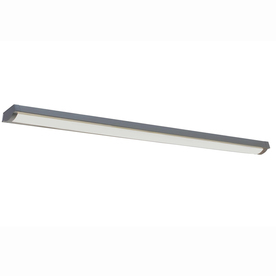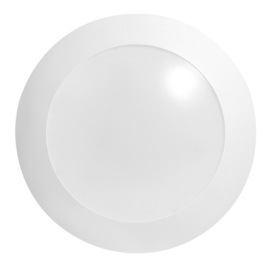Derek,
The easiest way - if you have garage doors with windows in them - is to locate the fixture such that it shines through the window when the garage door is up (but those windows are not all that popular, insofar that that creates a security issue (folks can see inside and see what you've got that's good to steal)).
Another option would be to angle some fluorescents from either side (assuming it had a reflector that created a 'beam' (hotspot on the floor) - but I can't recall any here at the moment that would do that) - but even a standard reflector *would* throw some light more to the side if it was mounted canted to that direction. Simply have to experiment on this one.
Yet another option would be to mount a fixture (and LEDs would probably be the best option here -- more robust and durable) on the inside of your garage door with a 'pigtail' (6"? 8"?) plug-in to it. When the door is up, stretch out an extension cord (even the lightweight (16-18 ga) lamp cord ones would do) and plug it in. Would need to pick a fixture that doesn't protrude too much - get a height that doesn't scratch the car finish if you were bump it inadvertantly. Rig up some hangers to the side (coat-hanger) to hold the extension cord up and out of the way. It would be even possible - with some experimentation - to have the fixture permanently wired. They make coiled power-rated cords (and, remember, we're only talking one (or two) fixtures) - and with some judicious routing, could be made to work.
Some LED fixture manufacturers:
https://www.rabweb.com/
https://www.e-conolight.com/ --- pretty decent pricing (and they list them)
https://www.lithonia.com/ --- more commercial grade (mid-range - but more expensive than above)
Additional comment (on 4' fluorescents): As noted, there are in the market today LED 'replacement bulbs' to fit these classic fixtures - and, as noted, they are expensive. However, getting the classic 4' T-8 fixture today (with fluorescent lamps) will still get you set for the future. LEDs are coming and will only get cheaper with time. There will also be all manner of LED 'replacement tubes' for all those millions of T-8 fixtures and they will get quite cheap. So, when your (purchased today) fluorescent needs replacement lamps, get the LEDs then. I would venture to guess that this 'form factor' will be with us for many decades into the future.
--john.






